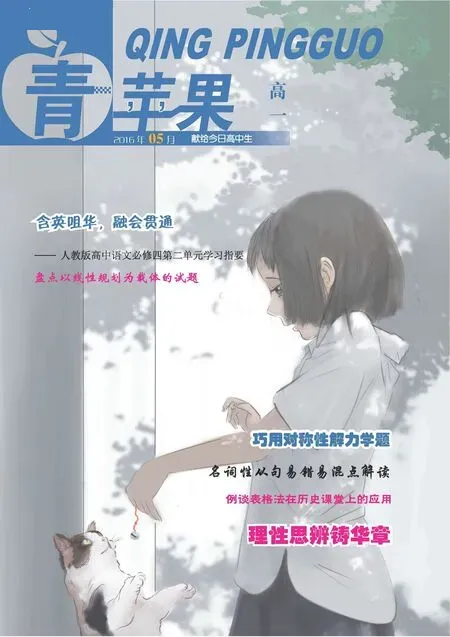容易出错的after用法小结
北方工业大学文法学院 宋蕾
容易出错的after用法小结
北方工业大学文法学院 宋蕾
在英语中,after是个常见词,也是个简单词,同学们都知道它是“之后”的意思,但往往忽略它的各种用法。事实上,after既可以表示时间意义上的“在……之后”,也可以表示空间意义上的“在……后面”。在单项选择题和完形填空题中,经常考查after作为介词、连词、形容词、副词以及其所构成的介词短语和习语的用法,这个简单词其实并不简单。
一、after和in
after和in都可以表示时间意义上的“在……之后”,作为介词使用。
1.当after表示“一段时间(a period oftime)以后”,表示已经发生的事实,动词要用过去时态。
可以说He arrived after four weeks,表示“他在四个星期后到达了”,但不可以说He will(would)arrive after four weeks。
2.表示将来,或以现在为起点的一段时间以后,不能用after,应该用in。所以上句改为:
He will(would)arrive in four weeks.他将于四周后到达。
或者改为:
He will arrive four weeks fromnow.
He would arrive four weeks fromthen.
3.如果是说“某个时刻(point oftime)或日期或事件以后”,可以用after。例如:
He will(would)arrive after four o'clock.他将在四点后到达。
He will(would)arrive after 5 July.他将于7月5日后到达。
He will(would)arrive after the ceremony.他将在典礼仪式后到达。
二、after和since
1.after用作介词时,表示“某时或某事之后”,但要表示“从过去的某时或某事开始,一直持续到现在”,就不能用after,要用since。
After his graduation he went abroad.他毕业后就出国了。
After his graduation he will goabroad.他毕业后就会出国。
但不可以说:After his graduation he has been abroad。
应改为:He has been abroad since his graduation.他毕业之后就出国了。
2.after用作连词时,只能表示“某时或某事之后”,不用于表示从过去持续到现在的状态。
He went abroad after he graduated.他毕业之后出国了。
但不可以说:He has been abroad after he graduated.
应改为:He has been abroad since he graduated.
三、after和past
after和past都可以作介词,表示“某时刻之后”,但美式英语中常用after,而英式英语中用past。
It's five minutes after eight.现在八点过五分。
It is nowexactlytwenty-eight minutes past eight.现在确切地说,是八点二十八分。
四、after和behind
1.after通常指时间先后的次序,behind通常指位置。
August comes after July.七月之后是八月。
Agarden lies behind the house.屋后是花园。
2.当表示位置在某人之后时,after和behind可以通用。
Please shut the door after(behind)you.请把你后面的门关起来。
He came in after(behind)you.他在你之后进来的。
3.当表示位置在某物之后时,不用after,而用behind。
Don't stand behind the door.不要站在门后。
The cat is sittingbehind the sofa.猫在沙发后面坐着。
4.固定的礼貌用语,表示请对方先行,用after you,不能用behind you。
After you,sir.您先请,先生。
After you with the paper.报纸你看完了给我看。
五、after和after all
1.after作介词时,可以与all连接,带有“尽管,虽然”的意思。这时不要误把after all当作成语来看。
After all his advice,she still gambles.虽然他极力劝告,但她还是赌博。
After all mycare,it was broken.尽管我精心照料,它还是碎了。
2.after与all连接时,有“虽然这样”的意思,因此所接的原因要符合逻辑。
In coming home we got caught in the rain and became wet through and through,after all I wish I hadn't joined in the outing.这句话前后矛盾,应改为:
In cominghome we got caught in the rain and became wet through and through,after all I don't mind as we had a fine time.回家时我们遇上大雨,浑身都湿透了。虽然这样,但我一点儿也不在意,因为我们玩得很愉快。
3.after all为成语,有“毕竟,到底,终究,最后”的意思,放在句中或句末使用。
What harmdoes it doafter all?这到底会造成什么危害?
Soyou did come after all.所以你最后还是来了。
六、after和afterwards
after可以用作副词,指时间上的“后来,之后”。但在日常口语中,最好避免使用after作副词,用afterwards或later时更多。
Soon after(用afterwards时更多),he went tolive in London.之后不久,他就搬到伦敦了。
He fell ill on Mondayand died three days after(用later时更多).他周一病倒了,三天之后就去世了。
We had dinner and went home after.我们吃过晚饭后回家了。
七、after用于介词短语和成语中
1.after用作介词时,除指时间或空间意义上的“在……之后”或“在……后面”,还可以表示“照……的样子,仿效,依照”的意思。
Will you please make a boxafter the model?你能照样子做个盒子吗?
Repeat the words after me,please.请跟我读。
2.be after作“追求,寻求”解。
He is after you.他正找你。
He is always after me toteach himEnglish.他老是要我教他英语。(注意after me后面要用不定式)
She is after your money.她想得到你的钱。
3.after one's heart合某人心意的
Mr.Smith is a man after myown heart.史密斯先生很合我的心意。
He likes basketball and good food;he is a man after my own heart.他喜欢篮球和美食,很合我的心意。
4.ask(inquire)after问候
She asked after you.她问候你。
Everyafternoon he called toinquire after her.每天下午他都打电话向她表示问候。5.goafter,hanker after,seek after追逐;追求;设法得到The dogwent after the wounded deer.猎狗追逐受伤的鹿。
Theyhankered after the bourgeois wayoflife.他们追求小资的生活方式。6.take after长得像;性格上像
The boytakes after his father.这个男孩长得像他的父亲。
7.look after照顾;照看
Look after yourself!照顾自己!
She's been lookingafter the luggage.她正在照看行李。
8.after a fashion介词短语,作状语,意为“多少,略微地”,与in a fashion同义。
Donna can sing after a fashion.唐娜多少能唱一些歌曲。
9.one after another一个接一个地
They rose one after another and walked out.他们一个接一个地起身离开。
Independence was proclaimed in one colonyafter another.殖民地一个接一个地宣布独立。
八、after用作形容词时,放在名词前,表示“后来的,以后的”。还可以用来合成复合式名词。
in after years在以后的岁月中
aftercare(病人出院后的)护理或治疗;(犯人出狱后的)安置
aftereffect(药物的)后作用;(疾病的)后遗症
afterglow(日落后的)余晖,晚霞
aftermath(战争、事故的)后果,创伤
aftershock(地震后的)余震
【考例分析】
1.His grandmother died on the eve of the Spring Festival but he arrived home four weeks.
A.inB.afterC.pastD.behind
【解析】B。考查after作介词的用法,表示时间意义上的“在……之后”,注意after与in的区别。after表示“一段时间(a period oftime)以后”,表示已经发生的事实,动词要用过去时态;而in则表示以现在为起点的一段时间以后,动词用将来时态,如He will(would)arrive in four weeks。他将于四周后到达。
2.I will leave after heback.
A.comeB.cameC.comesD.has come
【解析】C。考查after用作连词引导时间状语从句。当主句用将来时态,则after引导的时间状语从句要用一般现在时态表将来意义,而不能直接使用将来时态。
3.all we've said,he still won't change his mind. A.BesideB.BesidesC.BeforeD.After
【解析】D。考查after作介词时,可以与all连接,带有“尽管,虽然”的意思。因此,这句话的意思是:尽管我们说了那么多,他还是不肯改变主意。
注意这时不要误把after all当作成语来看。
4.Ofcourse he behaved awfully,but,he is onlysixyears old.
A.in factB.sofarC.after allD.on earth
【解析】C。考查after all作为习语的用法,表示“毕竟,到底,终究,最后”。句意为:当然他的表现糟糕透了,但不管怎么说,他毕竟只有六岁。
5.Doyou knowJoe paintedRaphael?
A.behindB.forC.withD.after
【解析】D。考查after用作介词时,除指时间或空间意义上的“在……之后”或“在……后面”,还可以表示“照……的样子,效仿,依照”的意思。句意为:你知道乔的画是仿效仿拉斐尔的吗?
6.“You're not fond ofwork,are you?”
“No,I takeyou.”
A.behindB.forC.withD.after
【解析】D。考查take after用作习语,表示“长得像,性格上像”。句意为:“你不喜欢工作,是吗?”“是的,就像你。”
7.His pictures were eagerly.
A.asked afterB.looked afterC.sought afterD.inquired after
【解析】C。考查seek after用作习语,表示“追逐,追求,设法得到”。句意为:人们千方百计要得到他的画作。goafter,hanker after等也表示同样的意思。
8.Small businesses have been collapsing.
A.one byoneB.hand in handC.one after anotherD.all in all
【解析】C。考查one after another作为习语,表示“一个接一个地”。句意为:小企业接二连三地倒闭了。one byone强调一次一个,一个一个地,例如:Write down your ideas one by one.(把你的想法逐一写下来。)one after another强调连续性,例如:Guests came one after another.(客人们陆续来了。)
9.The ceremonyofsigninghad tobe put off.
A.one byoneB.dayafter dayC.one after anotherD.the dayafter tomorrow
【解析】B。考查dayafter day作为习语,表示“日复一日”。句意为:签字仪式不得不日复一日地后延。同样的表达还有:year after year,week after week,hour after hour等。

